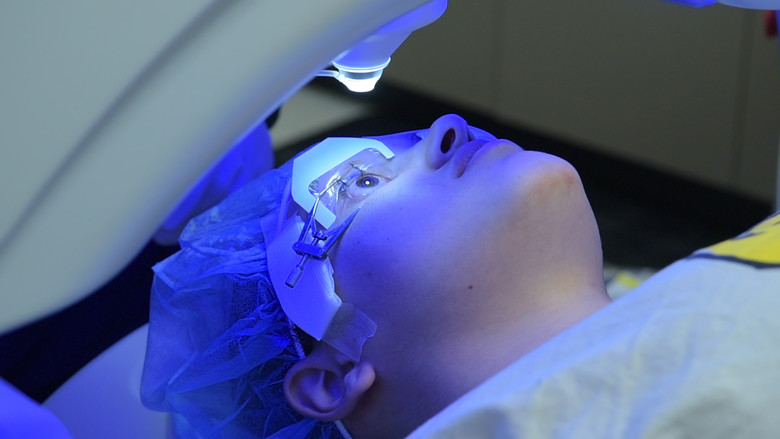Vision problems such as myopia, hyperopia, & astigmatism affect millions of people worldwide & can significantly impact daily life. Eyeglasses & contact lenses have long been the go-to solutions for correcting vision, but they can be cumbersome & uncomfortable. Fortunately, modern medical technology has given rise to a variety of surgical options for vision correction. In this blog, we will explore some of the most common vision problems, the drawbacks of traditional vision correction methods, & how SMILE eye surgery may offer a safe & effective alternative.
Contents
What Is SMILE Eye Surgery?
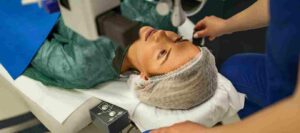 SMILE (Small Incision Lenticule Extraction) is a type of laser eye surgery used to correct refractive errors such as nearsightedness, farsightedness, & astigmatism. It involves creating a small, precise incision in the cornea to remove a small piece of tissue, reshaping the cornea & improving vision. The procedure is less invasive than traditional LASIK surgery & can result in faster healing times & less discomfort for the patient.
SMILE (Small Incision Lenticule Extraction) is a type of laser eye surgery used to correct refractive errors such as nearsightedness, farsightedness, & astigmatism. It involves creating a small, precise incision in the cornea to remove a small piece of tissue, reshaping the cornea & improving vision. The procedure is less invasive than traditional LASIK surgery & can result in faster healing times & less discomfort for the patient.
Procedure Of SMILE Eye Surgery
Here’s a detailed explanation of the SMILE Eye Surgery procedure:
1. Pre-operative examination
The pre-operative examination is a comprehensive eye exam that will be conducted by your eye doctor or surgeon. The exam will involve measuring your eye’s refractive error, corneal thickness, & overall eye health. Your medical history & any medications you are taking will also be reviewed to ensure that you are a suitable candidate for SMILE surgery.
2. Anesthesia
Before the procedure, your eye will be numbed using local anesthesia. This can be in the form of eye drops or an injection. Local anesthesia will prevent you from feeling any pain or discomfort during the procedure, but you will remain awake throughout.
3. Creating a small incision
The surgeon will create a small incision, approximately 2-4mm in length, on the surface of the cornea using a femtosecond laser. This laser creates a precise, computer-controlled incision that is smaller than the one made during traditional LASIK surgery. The small size of the incision means less disruption to the corneal tissue, less chance of dry eye symptoms, & a quicker recovery time.
4. Creating the lenticule
Using the same femtosecond laser, the surgeon will create a lenticule, a small, lens-shaped piece of tissue, inside the cornea. The laser precisely & accurately creates the lenticule by separating it from the surrounding tissue in the cornea. The lenticule will contain the precise amount of tissue that needs to be removed from the cornea to correct the refractive error.
5. Removing the lenticule
The surgeon will use a small instrument, called a spatula, to gently remove the lenticule through the incision created earlier. Once the lenticule is removed, the cornea naturally reshapes itself to correct the refractive error.
6. Reshaping the cornea
The cornea will naturally reshape itself as soon as the lenticule is removed. The reshaping of the cornea will correct the refractive error & improve vision. The laser used in SMILE surgery is highly accurate & precise, allowing for a customized correction of the refractive error to provide the best possible visual outcomes.
7. Closing the incision
The small incision will close naturally without the need for stitches. The cornea’s natural elasticity allows it to close the incision on its own, sealing the surface & reducing the risk of infection.
8. Post-operative care
After the procedure, you will be given eye drops to prevent infection, reduce inflammation, & promote healing. You will also be given instructions on how to care for your eyes in the days & weeks following the procedure. You will need to attend follow-up appointments to monitor your progress & ensure that your eyes are healing correctly. It is essential to follow all instructions given by your surgeon to achieve the best possible outcomes.
Advantages Of SMILE Eye Surgery Over Others
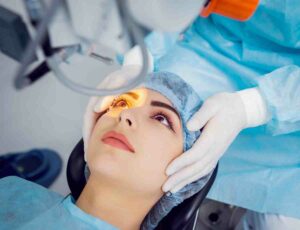 SMILE (Small Incision Lenticule Extraction) eye surgery has several advantages over other types of laser eye surgery, including:
SMILE (Small Incision Lenticule Extraction) eye surgery has several advantages over other types of laser eye surgery, including:
- Less invasive: The SMILE procedure is less invasive than traditional LASIK surgery. The small incision created during SMILE surgery is only 2-4mm in length, which is smaller than the incision made during LASIK surgery. This means less disruption to the corneal tissue, less chance of dry eye symptoms, & a quicker recovery time.
- Minimally disruptive: It is minimally disruptive to the cornea. The femtosecond laser used in the procedure creates a precise & highly accurate lenticule, which is removed through a small incision. This means there is less chance of flap-related complications, such as infections & dislodgement, which can occur with traditional LASIK surgery.
- Faster recovery: SMILE surgery offers a faster recovery time compared to traditional LASIK surgery. Patients typically experience less discomfort, dryness, & sensitivity after the procedure, & their vision can improve within a few days.
- Suitable for a wider range of patients: It is suitable for a wider range of patients than other types of laser eye surgery. The procedure can be used to treat nearsightedness, farsightedness, & astigmatism, & is suitable for patients with thinner corneas or those who are not good candidates for LASIK surgery.
- Enhanced safety profile: SMILE surgery has an enhanced safety profile compared to other types of laser eye surgery. The procedure reduces the risk of complications, such as dry eye symptoms, infections, & visual aberrations, & is safe & effective in clinical studies.
Risks & Limitations Of SMILE
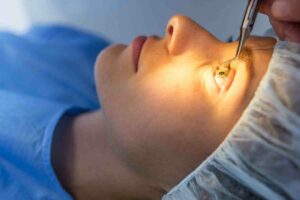 Like any surgical procedure, SMILE (Small Incision Lenticule Extraction) eye surgery carries some risks & limitations. It’s essential to understand these potential risks & limitations before deciding to undergo the procedure. Here are some of the most common risks & limitations of SMILE surgery:
Like any surgical procedure, SMILE (Small Incision Lenticule Extraction) eye surgery carries some risks & limitations. It’s essential to understand these potential risks & limitations before deciding to undergo the procedure. Here are some of the most common risks & limitations of SMILE surgery:
- Dry eye: Dry eye is a common side effect of SMILE surgery. This occurs because the procedure can disrupt the nerves that control tear production. Most patients will experience some degree of dryness & discomfort after the procedure, but these symptoms usually improve over time. Using eye drops as directed by your surgeon can help alleviate dry eye symptoms.
- Reduced night vision: Some patients may experience reduced night vision after SMILE surgery. This occurs because the procedure can cause visual aberrations, such as halos & glare, that can affect night vision. Most patients will experience a mild reduction in night vision that improves over time, but some patients may experience more significant & persistent problems.
- Overcorrection or under-correction: There is a risk of overcorrection or under-correction with any type of laser eye surgery, including SMILE surgery. Overcorrection occurs when too much tissue is removed from the cornea, leading to hyperopia or farsightedness. Undercorrection occurs when not enough tissue is removed, leading to residual myopia or nearsightedness. In some cases, additional surgery may be needed to correct the refractive error.
- Infection: There is a risk of infection with any surgical procedure. Your surgeon will take steps to minimize the risk of infection, such as using sterile instruments & prescribing antibiotics. It’s important to follow all post-operative instructions & attend follow-up appointments to monitor for signs of infection.
Recovery Process In SMILE Eye Surgery
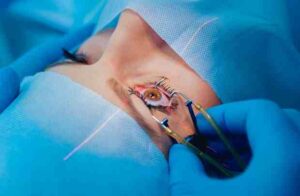 The recovery process for SMILE (Small Incision Lenticule Extraction) eye surgery is typically fast & straightforward. Most patients can expect to return to their normal activities within a few days of the procedure. Here is a general timeline of the recovery process:
The recovery process for SMILE (Small Incision Lenticule Extraction) eye surgery is typically fast & straightforward. Most patients can expect to return to their normal activities within a few days of the procedure. Here is a general timeline of the recovery process:
- Immediately after surgery: After the procedure, you will rest for a short period in the clinic. You will then be able to go home, but you will need someone to drive you. The surgeon will give you eye drops to use to help prevent infection & reduce inflammation.
- First few days after surgery: You should avoid strenuous activity, swimming, & contact sports for the first few days after the procedure. You may experience some discomfort, dryness, & sensitivity to light during this time. Your surgeon will provide you with instructions on how to manage these symptoms.
- First week after surgery: You will attend a follow-up appointment with your surgeon to monitor your healing progress. You may still experience some mild discomfort & dryness during this time, but your vision should continue to improve.
- First month after surgery: Your vision should continue to improve during this time. Most patients can return to their normal activities within a month of the procedure. You should continue to use eye drops as directed by your surgeon to promote healing. This will reduce the risk of infection.
- Long-term recovery: Your vision will continue to stabilize over the next few months. Attend follow-up appointments with your surgeon to monitor your progress. Most patients achieve their desired level of vision within a few months of the procedure.
Conclusion
In conclusion, SMILE eye surgery is a safe & effective procedure for the treatment of myopia, astigmatism, & some cases of hyperopia. It offers several advantages over traditional LASIK surgery, including a faster recovery time, fewer side effects, & lower risk of complications. However, like any surgical procedure, SMILE surgery carries some risks & limitations, & it’s essential to understand these before deciding whether the procedure is right for you. If you’re considering SMILE surgery, seek help from an experienced & qualified surgeon who can guide you through the process & answer any questions you may have.
Lasik surgery is a safe 10-minute procedure to help you get rid of glasses. EyeMantra offers the most advanced LASIK options including PRK, Femto LASIK, SMILE surgery, Standard LASIK, ICL, and Contoura vision. If you have any questions on LASIK surgery in Delhi, Lasik surgery cost, and Lasik procedure, call us at 9711116605 or email at [email protected].
